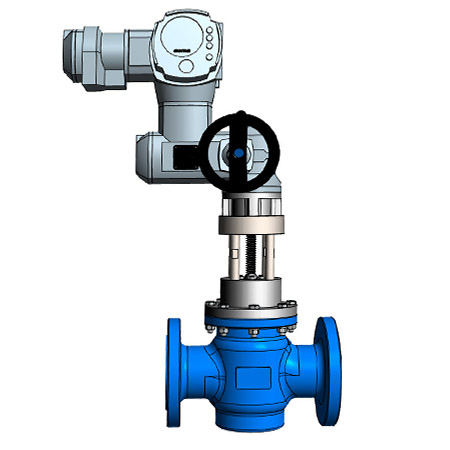Enhancing Functional Performance with Advanced Control Valves

Maximize Energy Financial Savings and Convenience With Advanced Building Automation Controls
In the world of modern architecture and facility monitoring, the combination of advanced building automation manages stands as a critical advancement. By utilizing the power of automation, structures can adapt, react, and evolve in methods that were when unthinkable.
Energy Effectiveness Benefits
Power effectiveness advantages can considerably minimize power usage and operational expenses in buildings. Energy-efficient systems, such as advanced structure automation controls, can enhance the usage of resources like heating, air conditioning, and lights, leading to reduced power costs over time.
Moreover, improved energy performance can prolong the lifespan of structure devices and systems. By operating much more successfully, HVAC systems, light, and various other building parts experience less damage, causing minimized upkeep and replacement prices. In addition, energy-efficient structures often regulate greater residential property worths and rental prices, offering long-lasting financial benefits to proprietors.
Additionally, power efficiency can enhance owner comfort and productivity. Effectively managed indoor atmospheres with optimum lights and thermal conditions create a more pleasant and conducive workspace, bring about enhanced staff member fulfillment and efficiency. On the whole, the power efficiency advantages connected with advanced building automation controls are diverse, including price savings, environmental stewardship, and occupant well-being.
Enhanced Convenience Control
Enhancing convenience control in structure atmospheres needs an advanced combination of innovative automation systems for optimal owner wellness. By utilizing innovative structure automation controls, facilities can customize the interior environment to satisfy the particular demands and preferences of occupants. These systems allow exact guideline of temperature, ventilation, and lighting, creating a comfy and efficient environment. Resident satisfaction and efficiency are closely linked to thermal comfort, making it vital to have systems in location that can adjust to changing problems in real-time.
By integrating these innovative controls, structures can not only improve comfort yet additionally improve power effectiveness by optimizing system operations based on actual tenancy and usage patterns. Eventually, focusing on resident convenience via sophisticated automation systems leads to a more pleasurable and much healthier interior environment.
Operational Performance Improvements

Furthermore, the execution of real-time monitoring and analytics tools allows structure drivers to identify power ineffectiveness and operational anomalies quickly. By continuously keeping an eye on energy use patterns and system efficiency metrics, changes can be made in real-time to optimize power consumption and guarantee peak functional performance. control valves. Furthermore, incorporating need reaction methods into building automation controls can additionally boost functional efficiency by dynamically changing energy use based upon grid conditions and pricing signals
Indoor Environment Optimization
Efficient interior environment optimization is a fundamental element of structure automation controls, ensuring why not look here owners' comfort and well-being while making the most of power cost savings. By making use of advanced sensors and controls, constructing automation systems can constantly keep track of and readjust temperature, humidity levels, air quality, and ventilation to produce an optimum interior setting. Preserving comfortable and constant conditions not only improves occupant fulfillment however likewise enhances performance and general wellness.
Interior environment optimization also plays an important role in power effectiveness. By fine-tuning air conditioning, air flow, and heating systems based upon real-time information and occupancy patterns, building automation controls can considerably reduce power intake - control valves. Carrying out methods such as demand-controlled air flow and thermal zoning can help lessen energy waste while ensuring that each area of the building obtains the essential conditioning.

Lasting Setting Creation
Building automation manages not only maximize indoor environment problems for power effectiveness and owner convenience however additionally lay the structure for producing a lasting atmosphere with tactical administration from this source of systems and sources. By integrating advanced structure automation technologies, such as sensing units, actuators, and smart software application, centers can change and check power usage in real-time to reduce waste and decrease their carbon impact. These systems enable predictive maintenance, determining potential concerns before they escalate and optimizing equipment performance to enhance long life and effectiveness.
Additionally, lasting setting development prolongs beyond power administration to include water conservation, waste decrease, and indoor air top quality renovation. Building automation controls can manage water use, discover leakages, and ensure proper garbage disposal methods, adding to general sustainability initiatives. Furthermore, by monitoring and controlling ventilation and purification systems, these modern technologies boost occupant wellness and performance while reducing energy usage associated with a/c procedures.
Verdict
To conclude, advanced structure automation manages deal substantial advantages in regards to power financial savings, convenience control, functional performance, interior environment optimization, and producing a lasting setting. By applying these controls, buildings can accomplish ideal efficiency while reducing energy consumption and improving owner comfort. It appears that using advanced automation modern technology is critical in boosting building efficiency and developing a much more sustainable future.
Power performance advantages can dramatically minimize power consumption and functional costs in More Bonuses buildings. Generally, the energy effectiveness advantages associated with innovative building automation controls are multifaceted, encompassing cost savings, ecological stewardship, and occupant health.
In addition, integrating demand response methods right into building automation controls can further improve functional performance by dynamically changing power usage based on grid problems and prices signals.
Building automation manages not only optimize interior environment problems for energy performance and passenger convenience yet additionally lay the structure for creating a lasting environment through tactical administration of systems and resources.In verdict, advanced building automation controls deal considerable benefits in terms of energy financial savings, convenience control, operational performance, indoor climate optimization, and creating a sustainable setting.